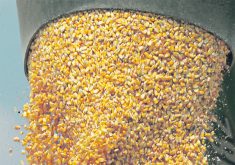China’s apparently insatiable demand for soybeans and South America’s rise as a soybean exporter are arguably the biggest stories in global agriculture in the last decade.
But what about corn?
Predictions that China will turn into a net corn importer go back at least 10 years, but so far the Asian giant has been able to keep ahead of demand, although only by slim margins.
Demand has risen 36 percent in the last 10 years and shows no sign of stopping. The effort to meet demand has already ended China’s position as a regional corn exporter.
Read Also

Chinese, Indian tariffs take toll on pea prices
The disruption of pea exports from Canada’s largest customers will likely result in slow pea exports for the remainder of the crop year.
The U.S. Department of Agriculture’s China attaché estimates the country’s corn demand at 149.5 million tonnes in 2008-09, 153 million tonnes in 2009-10 and 156 million in 2010-11.
Concerns about China’s ability to meet its corn needs rose last fall when it became clear production was less than Beijing’s forecasts and indeed was well short of consumption because of drought. However, the government had large stocks and was able to backfill the shortfall without turning to imports.
In 2010-11, production is expected to exceed consumption by four percent if the weather co-operates.
Last week, Qian Keming, director-general of the agriculture ministry’s market and economic information department, told Reuters News Service that the country is comfortable importing two-thirds of its soybean needs but wants to remain as self-sufficient as possible in corn. The country has had a long-standing goal of domestically producing 95 percent of its corn, wheat and rice needs.
However, there are concerns about the country’s ability to do that.
“Corn is what we are most concerned about because domestic demand is increasing rapidly while supply will tighten in the long term,” Qian said.
“We cannot import two-thirds from the world market (like soy).”
Last November, the government in Beijing set out a policy with the goal of increasing grain production to 550 million tonnes by 2020 from 500 million today. The plan would require yield increases of almost one percent per year through increased use of fertilizer and improvements in seed, production and irrigation technology.
Seeded acreage can’t grow because farmland is under severe pressure from increasing urbanization and industrialization.
Other challenges are comparatively low returns from farming and the migration of the agricultural labour force to the cities. Water quantity and quality are under pressure, as is the environment generally.
The government supports corn prices to try to keep farmers on the land, but over the next decade the overwhelming attraction of higher paying urban jobs will continue the transformation of rural society that is already well underway.
Nevertheless, the government appears intent on making its plan work. I’ve never found an authoritative explanation why China’s leaders are content to import soybeans but not corn or wheat.
It might be that they think the quantities they would need aren’t available. The United States’ ethanol program has soaked up most of the world’s surplus corn production capacity.














